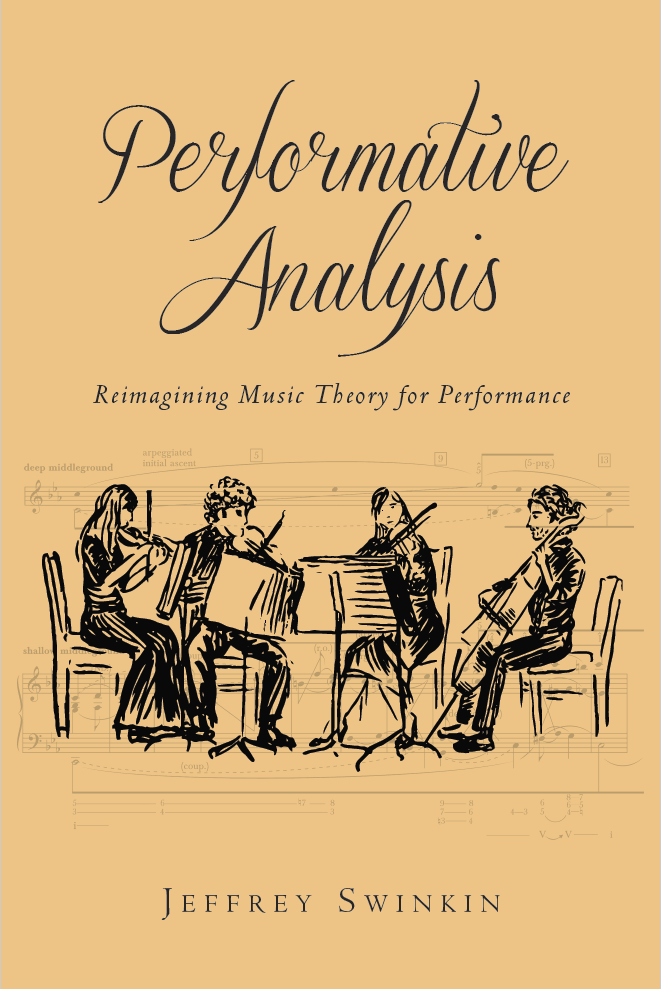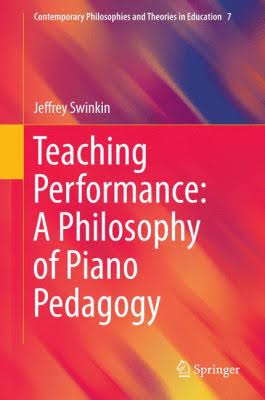Publications
“What Variations Do: Toward a Methodology for Analyzing Tonal Variation Sets.” In The Oxford Handbook of Musical Variation. ed. Jeffrey Swinkin. New York: Oxford University Press, 2025.
This chapter has a twofold purpose: to outline a broadly applicable method for analyzing variation sets and to argue for the capacity of even comparatively “light” sets to grapple with the nature of their respective themes and to unfold structural narratives.
The Oxford Handbook of Musical Variation. ed. Jeffrey Swinkin. New York: Oxford University Press, 2025.

Variation is among the most fundamental and essential musical processes. Yet, variation as a form has often been overlooked and undervalued for several reasons, including its formally fragmentary nature and its heavy reliance on melodic decoration. Across forty-two essays by forty-six authors from around the world, The Oxford Handbook of Musical Variation seeks to restore faith in this traditionally underemphasized form. It also examines variation as a technique apart from variation form—a technique that is integral to music of virtually all styles, forms, and genres. While exploring the traits of musical variation that have proven consistent over time, the volume also considers the diverse ways in which those traits have been treated, analyzing myriad works and their unique deployment of variational techniques.
Perspectives on Contemporary Music Theory: Essays in Honor of Kevin Korsyn, co-edited with Bryan Parkhurst. New York: Routledge, 2023.

This book, a festschrift for Kevin Korsyn (who was my Ph.D. advisor), comprises essays that constellate around his numerous scholarly foci. Represented in the volume are not only familiar music-theoretical topics such as chromaticism, form, Schenker, and text-music relations, but also various interdisciplinary topics such as deconstruction, disability studies, German Idealism, posthumanism, and psychoanalysis. The book thus reflects the increasingly multifaceted intellectual landscape of contemporary music theory.
“The E-flat/B Complex in Nineteenth-Century Music and Its Hermeneutic Dimensions,” co-written with Hayley Grigg. In Perspectives on Contemporary Music Theory: Essays in Honor of Kevin Korsyn, eds. Bryan Parkhurst and Jeffrey Swinkin. New York: Routledge, 2023.
When E-flat and B interact in salient and sustained fashion in a piece or a multipiece work, we describe that piece or work as hinging on an E-flat/B complex. Our task is to assess hermeneutic significance in E-flat/B-oriented works spanning the years 1827-1869. Schubert’s Die Winterreise and Piano Trio in E-flat major, Schumann’s Rhenish Symphony, and Faust-themed operas by Berlioz and Gounod count among our examples.
“Cyclic Form in Clara Schumann’s Four Fugitive Pieces, op. 15.” Intégral 36 (2023).
This essay demonstrates several ways in which Clara Schumann’s Four Fugitive Pieces, op. 15 is cyclically integrated. First, the four pieces trace a progressive (rather than static) tonal scheme. Second, they are interlinked by a taut motivic web. Third, no. 1 harbors a melodic implication that no. 4 realizes. Fourth, no. 1 distinctly implies yet elides two keys that are respectively articulated by nos. 2 and 3. Finally, no. 1 foments a hypermetric conflict that no. 3 settles, if briefly. The essay then suggests that the cycle questions its own unity by closing with a scherzo. As a light genre typically found in the second or third position of a four-movement cycle, it cannot bear the burden of definitively finishing the piece. In the end, Schumann’s op. 15 is a Romantic fragment, a notion I briefly elaborate.
Review of From Silence to Sound: Beethoven’s Beginnings, by Jeremy Yudkin. Nineteenth-Century Music Review 19, no. 1 (April 2022).
“Analytic Context and Aesthetic Properties: Listening to Beethoven’s Largo appassionato from Op. 2, No. 2.” Intégral 33 (2019).
Just as a score allows for many plausible performative interpretations, so a given performance allows for many plausible hearings. Such hearings are delimited not only by the material features of the performance—its dynamic fluctuations, for instance—but also by the context within which we hear those features. Analysis may comprise one such context.
“Paratactic Performance: Toward an Adornian Theory of Musical Interpretation.” International Review of the Aesthetics and Sociology of Music 50 (2019): 221–53.
From certain remarks in Adorno’s Towards a Theory of Musical Reproduction, one can infer that, for him, parataxis is a crucial performative criterion. Paratactic playing allows the cracks and tensions of musical structure to manifest, rather than attempting to smooth them over with a beautiful sound and long lines. More broadly, such playing liberates the work from the domination of an exegetical interpreter, just as Hölderlin liberates nature from logos and Schubert musical material from willful, organic connections. Such subject/object autonomy—such separating the part from the whole—is, by Adorno’s lights, true to the modern, disenchanted human condition. In it, the individual cannot and should not purport to be compatible with a greater whole since that whole has been irredeemably tainted, co-opted by oppressive powers.
“‘Breakout’ Themes in Classical Sonata Forms.” Theory and Practice 43 (2018): 33–75.
In some sentential Classical themes, the initial presentation module is followed by a continuation module that retrospectively becomes a new presentation, thus triggering a new sentence. In other cases, the presentation (or compound basic idea) is followed by a continuation that retrospectively becomes the antecedent of a period.
The Norton Guide to Teaching Music Theory, co-edited with Rachel Lumsden. New York: W. W. Norton, 2017.

This is the first book of its kind, with over 20 essays by scholars from across the discipline on all aspects of theory pedagogy, including social equality in the classroom, theory and performance, aural skills, music cognition, movement, improvisation, model composition, and much more.
“Teaching by Example: Experiential Dimensions of the Theory Classroom.” In The Norton Guide to Teaching Music Theory, eds. Rachel Lumsden and Jeffrey Swinkin. New York: W. W. Norton, 2017.
In teaching concepts, one can go beyond merely referring to them (denoting them) in order to exemplify them—to exhibit in one’s very discourse and class structure some of their underlying characteristics. One can do this because theoretical concepts are metaphorical for more fundamental human experiences—social, emotional, and psychological. One should do this because it makes otherwise abstract concepts more concrete, otherwise esoteric ones more familiar, and thus instills them in the student in a deeper, more intuitive way.
“‘About a Key’: Tonal Reference in Beethoven’s Sonata-Form Works.” The Journal of Musicology 34, no. 3 (2017): 515–558.
In the sonata practice of the mid-eighteenth century, composers frequently asserted the minor dominant prior to the major dominant in the second part of the exposition. Beethoven dramatized this technique, graduating from using the “wrong” mode to using the “wrong” key. In many such circumstances, the result for the recapitulation is that the tonic arrival in the secondary theme is deferred, such that when the tonic does belatedly arrive, the listener is more cognizant of it. In this way, Beethoven brings the resolution of large-scale tonal dissonance to the fore. I suggest that such a tactic is metamusical—that Beethoven was in a sense writing music about music.
Performative Analysis: Reimagining Music Theory for Performance. Rochester: University of Rochester Press, 2016.

Analytical insights are artistic interpretations, not scientific, objective facts. As such, the performance need not somehow express or communicate them in order to prove its validity. The imperative, rather, is to respond to such insights in various creative ways.
Teaching Performance: A Philosophy of Piano Pedagogy. Cham, Switzerland: Springer, 2015.

Treating the process of learning a piece as a means to an end diminishes the means and thus ultimately the end. Conversely, treating the means as autonomous in relation to the end result develops an interpretation more fully and thus ultimately produces a better result. In this sense, the distinction between autonomy and utility is specious.
“An Account of Emotional Specificity in Classic-Romantic Music.” Current Musicology 94 (2013): 97–126.
The relatively generic emotions that music expresses via foreground gestures and topics and the like are considerably specified by deeper motivic and voice-leading structures and by how foreground and deeper structures interact.
“The Middle-Style/Late-Style Dialectic: Problematizing Adorno’s Theory of Beethoven.” The Journal of Musicology 30, no. 3 (2013): 287–329.
The organic unity that Adorno declares a hallmark of Beethoven’s middle style can, with a Schenkerian lens, also be seen in the late style. Conversely, the fragmentary quality that Adorno declares a hallmark of the late style can be seen in the middle style.
“Variation as Thematic Actualisation: The Case of Brahms’s Opus 9.” Music Analysis 31, no. 1 (2012): 37–89.
In many sets, the titular one included, variations do not primarily decorate their theme but rather expose dimensions of it that might otherwise remain latent. In this sense, such variations effectively define the theme, in retrospect.
“Schenkerian Analysis, Metaphor, and Performance.” College Music Symposium 47 (2008): 76–99.
Schenkerian tools and concepts are metaphors for physical and emotional experience. It is the latter, not the former per se, that are fruitful for the performer.
This article, reworked and expanded, comprises Chapter 3 of Performative Analysis.
“Keyboard Fingering and Interpretation: A Comparison of Historical and Modern Approaches.” Performance Practice Review 13 (2007).
Some fingerings are more gestural than others, more congruent with the articulation and phrasing they are meant to execute. Other fingerings are more conducive to long lines and thus indifferent to localized articulations. The fingerings of C.P.E. Bach, Beethoven, Chopin, and Schenker tend to fall into the former category.
“Teaching Piano With Structure.” American Music Teacher (2006): 14–18.
One can teach a studio lesson with a sense of structure in multiple ways and on multiple levels—from attending to a piece’s form (inner and outer) to actually structuring and unifying the lesson itself.
“Reference and Schenkerian Structure: Toward a Theory of Variation.” Indiana Theory Review 25 (2004): 177–222.
Variations often bring deep-seated, Schenkerian features to the surface, a process I liken to Nelson Goodman’s notion of exemplification. One instance of musical exemplification is motivic parallelism, as when the Urlinie is transferred to the foreground.